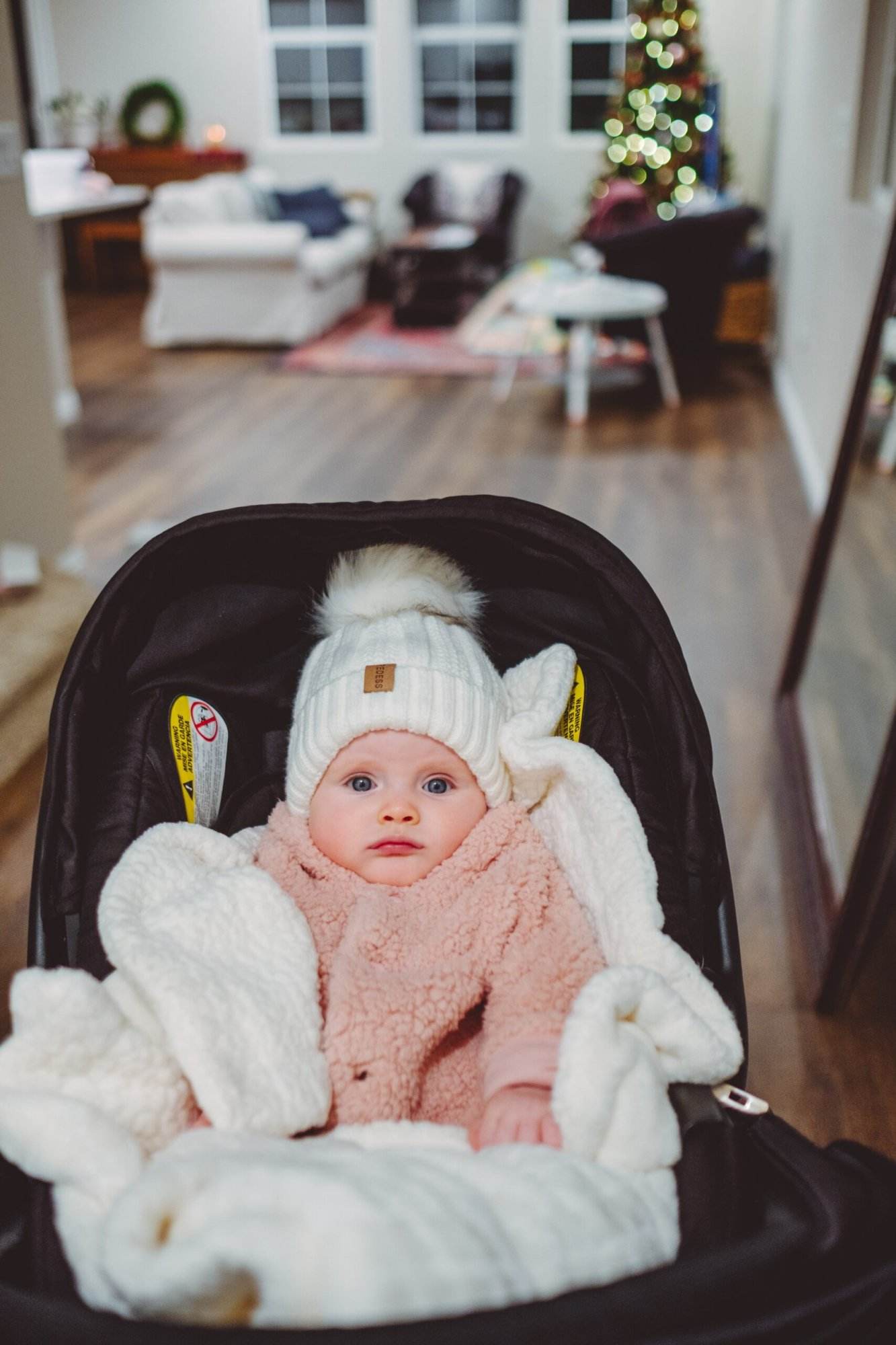Are you tired of your baby’s head constantly falling forward in their car seat? You’re not alone. Many parents struggle with this common issue, but fret not, there are simple solutions to help keep your baby’s head in a more comfortable and upright position during car rides. From adjusting the car seat straps to using specialized accessories, this article will provide you with practical tips and tricks to prevent your little one’s head from drooping forward and ensuring a safer, more enjoyable journey for both of you.

Choosing the Right Car Seat
Selecting a Car Seat with Suitable Recline Options
When it comes to choosing the right car seat for your baby, one important factor to consider is the recline options it offers. Babies have limited neck control and their heads tend to fall forward when they are asleep, which can be uncomfortable and potentially unsafe. Look for a car seat that offers multiple recline positions, allowing you to find the right angle to support your baby’s head and keep it from falling forward.
Ensuring Proper Installation of the Car Seat
Proper installation of a car seat is crucial for your baby’s safety. A poorly installed car seat can not only compromise the effectiveness of the seat in the event of a collision but also affect the stability and support it provides for your baby’s head. Follow the manufacturer’s instructions carefully and consider seeking the help of a certified child passenger safety technician who can ensure that the seat is installed correctly.
Using the Car Seat’s Headrest and Straps Appropriately
The headrest and straps of a car seat play a vital role in supporting your baby’s head and keeping it in a safe position. Make sure to adjust the headrest to the appropriate height for your baby to prevent their head from falling forward. Additionally, ensure that the harness straps are snug enough to hold your baby securely in place but not too tight to cause discomfort. Regularly check and adjust the headrest and straps as your baby grows to maintain proper support.
Making Adjustments to the Car Seat
Testing the Recline Positions and Adjusting as Needed
Even with a car seat that offers multiple recline positions, it may take some trial and error to find the best position for your baby. Take the time to test each recline position and observe your baby’s head position. If their head tends to fall forward in a particular position, try adjusting to a different angle until you find the most suitable recline position that supports their head and keeps it from falling forward.
Using Padding or Inserts for Additional Support
If your baby’s head still tends to fall forward despite adjusting the recline position, consider using padding or inserts for additional support. There are various products available, such as foam inserts or rolled-up blankets, that can be strategically placed to provide extra cushioning and prevent your baby’s head from flopping forward. However, make sure not to compromise the safety of the car seat by using unauthorized aftermarket accessories.
Considering the Use of a Car Seat Mirror
A car seat mirror can be a helpful accessory to monitor your baby’s head position while driving. By installing a mirror on the backseat, you can easily glance at it and see if your baby’s head is falling forward. This allows you to make quick adjustments or pull over if necessary to ensure your baby’s comfort and safety. However, make sure the mirror is securely installed and doesn’t pose any hazards or distractions while driving.
Using Support Accessories
Using a Head Support Cushion for Infants
For newborns and younger babies, a head support cushion can provide additional support and help prevent their head from falling forward. These cushions are specifically designed to cradle the baby’s head and neck, offering extra stability and comfort. When using a head support cushion, ensure that it is approved for use with your specific car seat model and that it doesn’t interfere with the proper fit and function of the harness system.
Integrating a Baby Neck Support Pillow
As your baby grows, they may still need some extra support to maintain proper head positioning in the car seat. A baby neck support pillow can be a useful accessory for this purpose. These pillows are designed to help keep the baby’s head upright and prevent it from falling to the side or forward. Choose a pillow that is specifically designed for use in car seats and make sure it doesn’t restrict your baby’s movement or compromise their safety.
Using a Car Seat Strap or Strap Covers
Sometimes, the straps of a car seat can cause discomfort or irritation for your baby, leading them to tilt their head forward or move around excessively. Using a car seat strap or strap covers can help alleviate this issue. Strap covers are soft, cushioned pads that can be wrapped around the harness straps, providing a more comfortable experience for your baby. Ensure that the strap covers do not interfere with the proper fit and function of the harness system or compromise the safety of the car seat.
Utilizing Shoulder Pads or Harness Sleeves
Shoulder pads or harness sleeves can also be beneficial in preventing your baby’s head from falling forward. These accessories add extra cushioning and padding to the shoulder straps, ensuring a comfortable fit and reducing the likelihood of discomfort that may cause your baby to adjust their head position. Just like with strap covers, make sure the shoulder pads or harness sleeves do not interfere with the correct functioning of the harness system or compromise the safety of the car seat.
Incorporating Proper Positioning Techniques
Ensuring the Correct Harness Tightness
Proper harness tightness is essential to keep your baby secure and maintain the correct head position. The harness straps should be snug enough so that you can only fit one or two fingers between the straps and your baby’s shoulders, but not so tight that it causes discomfort or restricts movement. Regularly check and adjust the harness tightness to ensure it is correctly fitted and provides optimal support for your baby’s head.
Positioning the Shoulder Straps Properly
In addition to harness tightness, the positioning of the shoulder straps is crucial to maintaining a secure and safe head position. The straps should be at or slightly below your baby’s shoulder level, ensuring that they are properly secured in the car seat. Incorrectly positioned shoulder straps can cause your baby’s head to tilt forward or lead to a loose fit, increasing the risk of injury in the event of an accident.
Positioning the Chest Clip at the Correct Height
The chest clip of the car seat harness plays a significant role in securing your baby in the seat and maintaining proper head positioning. It should be positioned at armpit level, ensuring that the shoulder straps stay in place and the harness remains snug. Placing the chest clip too high or too low can affect the fit of the harness, potentially causing your baby’s head to fall forward. Always double-check the position of the chest clip before starting a journey.
Maintaining the Correct Angle of the Car Seat
Many car seats are equipped with adjustable bases that allow you to alter the angle of the seat to accommodate your baby’s needs. Ensuring the correct angle is crucial, especially for newborns and infants who cannot sit upright unassisted. Consult the manufacturer’s guidelines for your specific car seat model to determine the recommended recline angle. With the right angle, your baby’s head is less likely to fall forward, keeping them comfortable and safe.

Monitoring the Baby’s Head Position
Regularly Checking on the Baby While Driving
While driving, it’s essential to keep an eye on your baby’s head position to ensure they are comfortable and safe. Glance at your rearview mirror or utilize other car mirrors to regularly check on your baby while driving. If you notice their head tilting forward or any discomfort, adjust their position or make necessary changes to support their head properly.
Adjusting the Head Position If It Starts to Fall Forward
If you notice your baby’s head starting to fall forward while driving, it’s important to take action promptly. Gently reach back and adjust their head position by gently pushing it back to a more comfortable and supported position. However, avoid making any adjustments while the car is in motion to prevent distractions or compromises to your own driving safety.
Using a Mirrored Visor to Monitor the Baby
A mirrored visor attached to the backseat headrest can be a useful tool for monitoring your baby’s head position while driving. The visor allows you to see a reflection of your baby’s face without turning your head, making it easier to detect any issues with their head position and make adjustments if necessary. Ensure that the visor is securely attached and doesn’t obstruct your view or pose any safety risks.
Utilizing a Baby Monitor or Camera System
For added peace of mind, you can consider using a baby monitor or camera system specifically designed for use in a car. These devices allow you to keep a close eye on your baby’s head position through live video feed or audio monitoring. With a baby monitor or camera system, you can quickly detect any problems with your baby’s head falling forward and take appropriate measures to ensure their comfort and safety while driving.
Educating Yourself on Potential Risks
Understanding the Dangers of an Incorrect Head Position
An incorrect head position in a car seat can pose various risks, including discomfort, restricted airways, and an increased risk of injury in the event of an accident. It’s important to understand the potential dangers associated with your baby’s head falling forward and take appropriate measures to prevent these risks.
Recognizing the Signs of an Unsafe Head Forward Position
Being able to recognize the signs of an unsafe head forward position is crucial in maintaining your baby’s safety. Watch out for signs such as excessive slumping or flopping of the head, the chin resting on the chest, restricted breathing, or discomfort displayed by your baby. By recognizing these signs, you can address the issue promptly and prevent potential harm to your baby.
Learning About the Possible Consequences
It’s important to educate yourself about the potential consequences of an incorrect head position in a car seat. These consequences can range from discomfort and irritability to serious safety risks in the event of a collision. By understanding the potential consequences, you can take the necessary steps to ensure your baby’s head is properly supported and prevent any harm that may arise from an unsafe head forward position.

Taking Regular Breaks and Stops
Planning for Frequent Breaks During Long Drives
If you’re embarking on a long journey with your baby, it’s important to plan for frequent breaks and stops along the way. Regular breaks not only give you an opportunity to stretch your legs and refresh yourself but also allow your baby to get out of the car seat and change their position. This can help prevent their head from falling forward due to prolonged sitting in a static position.
Providing Opportunities for the Baby to Stretch
During stops and breaks, provide opportunities for your baby to stretch and move around. Encourage gentle stretching exercises or engage in short play sessions outside the car seat. By allowing your baby to stretch and move their body, you can help alleviate any discomfort or tension that may contribute to their head falling forward in the car seat.
Allowing for Naps Outside the Car Seat
If your baby tends to fall asleep in the car seat and frequently experiences their head falling forward during naps, consider allowing them to take naps outside the car seat whenever possible. This could include babywearing in a carrier or providing a safe sleeping environment, such as a crib or bassinet, during nap times. By providing alternative sleeping arrangements, you can help prevent any issues with your baby’s head falling forward while sleeping in the car seat.
Adjusting the Baby’s Clothing and Accessories
Avoiding Bulky or Loose Clothing
When dressing your baby for car seat journeys, it’s important to avoid bulky or loose clothing that could interfere with the proper fit of the harness system. Bulky clothing can create gaps between your baby’s body and the car seat, increasing the risk of their head falling forward. Dress your baby in clothing that fits snugly and avoids any excess material that may affect the safety of the car seat.
Adjusting Clothing Layers for Temperature Control
Proper temperature control is essential for your baby’s comfort and safety during car journeys. Instead of dressing your baby in one thick layer, consider using multiple thin layers that can be easily adjusted. This allows you to add or remove layers according to the temperature, ensuring that your baby remains comfortable and reducing the likelihood of their head falling forward due to overheating or discomfort.
Removing Potential Obstructions around the Head
Before placing your baby in the car seat, make sure there are no potential obstructions around their head. This includes removing any toys, blankets, or loose items that could accidentally fall onto their head and push it forward. By keeping the area around your baby’s head clear, you minimize the risk of their head falling forward due to external obstructions.
Being Mindful of Cap or Hat Choices
While caps or hats can be cute and practical accessories for your baby, they can also contribute to their head falling forward in a car seat. Keep in mind that certain cap or hat styles can push the baby’s head forward or restrict their movement, making it more difficult for them to maintain a comfortable head position. Choose caps or hats that are specifically designed for use in car seats or consider removing them during car journeys if they interfere with the proper fit and function of the car seat.

Seeking Professional Advice
Consulting with a Certified Child Passenger Safety Technician
If you want to ensure that your baby’s head is properly supported in the car seat, consider consulting with a certified child passenger safety technician. These professionals are trained in car seat safety and can provide valuable guidance on selecting and installing the right car seat for your baby, as well as ensuring proper head positioning and overall safety. They can also address any specific concerns or questions you may have regarding your baby’s head falling forward in the car seat.
Reaching Out to Pediatricians or Healthcare Providers
Your pediatrician or healthcare provider can also offer valuable advice and guidance regarding head positioning in a car seat. They can provide recommendations based on your baby’s individual needs and ensure that you are following the best practices for your baby’s safety. Don’t hesitate to reach out to them if you have any concerns or questions about your baby’s head falling forward in the car seat.
Attending Car Seat Safety Check Events
Many communities organize car seat safety check events where certified child passenger safety technicians are available to inspect and help with the correct installation of car seats. These events provide an excellent opportunity to have your car seat checked and receive hands-on support and guidance regarding proper head positioning. Check with local authorities, community centers, or healthcare facilities for information on upcoming car seat safety check events in your area.
Additional Tips and Considerations
Keeping the Car Seat Clean and Free from Debris
Regularly clean and maintain your car seat to ensure its functionality and cleanliness. Dirt, debris, or loose objects in the car seat can affect proper head positioning, leading to discomfort or safety issues. Follow the manufacturer’s instructions for cleaning the car seat, including removing and washing removable covers or pads. Keep the car seat free from clutter and check for any foreign objects before placing your baby in the seat.
Avoiding the Use of Aftermarket Accessories
While there are many aftermarket accessories available for car seats, it’s crucial to avoid using unauthorized or untested products. These accessories may not be designed or tested for use with your specific car seat model, and they can compromise the safety and functionality of the seat. Stick with the original accessories provided by the car seat manufacturer or consult with a certified child passenger safety technician for approved accessories that can ensure proper head positioning.
Considering the Use of Specialized Car Seat Options
In some cases, specialized car seat options may be available to address specific concerns or challenges related to head positioning. These options may include car seats designed for children with certain medical conditions or car seats with enhanced head and neck support features. If you have specific concerns regarding your baby’s head falling forward in a car seat, consult with a certified child passenger safety technician or your healthcare provider to explore any specialized car seat options that may suit your needs.
Seeking Assistance from Experienced Parents
Seeking advice or support from experienced parents can also be valuable when it comes to addressing concerns about your baby’s head falling forward in a car seat. They may have encountered similar challenges and can share their insights, tips, and techniques that have worked for them. Utilize parenting communities, online forums, or social media groups to connect with experienced parents who can provide guidance based on their own experiences.
In conclusion, ensuring proper head positioning in a car seat is crucial for your baby’s comfort and safety. By selecting a car seat with suitable recline options, installing it correctly, and using the headrest and straps appropriately, you can provide optimal support for your baby’s head. Making adjustments to the car seat, utilizing support accessories, and incorporating proper positioning techniques further enhance head support. Regularly monitoring your baby’s head position, educating yourself on potential risks, and taking necessary breaks during long drives contribute to their overall well-being. Adjusting the baby’s clothing and seeking professional advice from certified child passenger safety technicians or healthcare providers are also important factors to consider. By implementing these tips and considerations, you can help prevent your baby’s head from falling forward in a car seat and create a safe and comfortable environment for travel.






